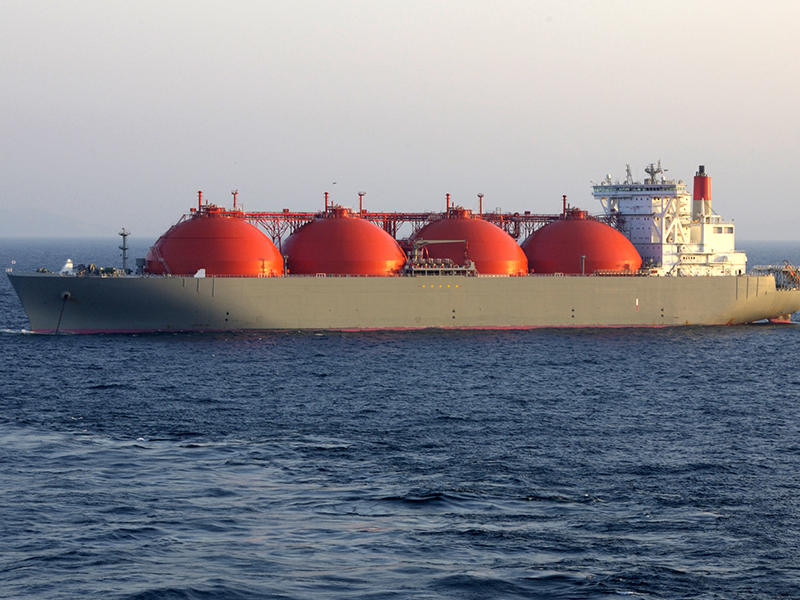begin quote from:
Natural gas explainedLiquefied natural gas
What is LNG?
Liquefied natural gas (LNG) is natural gas that has been cooled to a liquid state (liquefied), at about -260° Fahrenheit, for shipping and storage. The volume of natural gas in its liquid state is about 600 times smaller than its volume in its gaseous state in a natural gas pipeline. This liquefaction process, developed in the 19th century, makes it possible to transport natural gas to places natural gas pipelines do not reach and to use natural gas as a transportation fuel.
LNG increases markets for natural gas
Where natural gas pipelines are not feasible or do not exist, liquefying natural gas is a way to move natural gas from producing regions to markets, such as to and from the United States and other countries. Asian countries combined account for the largest share of global LNG imports.
LNG export facilities receive natural gas by pipeline and liquefy the gas for transport on special ocean-going LNG ships or tankers. Most LNG is transported by tankers called LNG carriers in large, onboard, super-cooled (cryogenic) tanks. LNG is also transported in smaller International Organization for Standardization (ISO)-compliant containers that can be placed on ships and on trucks.
At import terminals, LNG is offloaded from ships and is stored in cryogenic storage tanks before it is returned to its gaseous state or regasified. After regasification, the natural gas is transported by natural gas pipelines to natural gas-fired power plants, industrial facilities, and residential and commercial customers.
In the United States, some power plants make and store LNG onsite to generate electricity when electricity demand is high, such as during cold and hot weather, or when pipeline delivery capacity is constrained or insufficient to meet increased demand for natural gas by other consumers. This process is called peak shaving. The power plants take natural gas from natural gas pipelines, liquefy it in small-scale liquefaction facilities, and store it in cryogenic tanks. The LNG is regasified and burned by the power plants when needed. Some ships, trucks, and buses have specially designed LNG tanks to use LNG as fuel.
U.S. LNG imports peaked in 2007
The United States imported very small amounts of LNG until 1995, and then LNG imports generally increased each year until peaking in 2007 at about 771 billion cubic feet (Bcf) and equal to about 17% of total natural gas imports. LNG imports declined in most years since 2007 as increases in U.S. natural gas production and expansion of the natural gas pipeline network reduced the need to import natural gas.
In 2020, the United States imported about 49.2 Bcf of LNG from just four countries. This was the lowest amount since 1996 and equal to about 2% of total U.S. natural gas imports.
- The source countries, amounts, and percentage shares of total LNG imports in 2020 were:
- Trinidad and Tobago39.23 Bcf79.7%
- Nigeria6.91 Bcf14.0%
- Norway3.03 Bcf6.2%
- Canada0.04 Bcf0.1%
The Everett regasification terminal near Boston, Massachusetts, receives most U.S. LNG imports, and in 2020, it receved 60% of total U.S. LNG imports; 95% from Trinidad and Tobago and 5% from Nigeria. New England states: Connecticut, Maine, Massachusetts, New Hampshire, Rhode Island, and Vermont, may have significant pipeline constraints when heating demand increases substantially during periods of very cold weather. LNG imports help to meet natural gas demand in New England because the region currently has limited pipeline interconnections with the Northeast and other U.S. natural gas producing regions.
U.S. LNG export capacity and exports increased substantially between 2016 and 2020
The United States was a net exporter of LNG in 2017 through 2020 (exports were greater than imports), largely because of increases in U.S. natural gas production, declines in natural gas imports by pipeline and as LNG, and increases in LNG export terminal capacity.
U.S. LNG export capacity increased from less than 1 billion cubic feet per day (Bcf/d) in 2015 to 10.8 Bcf/d at the end of 2020. In 2015, total U.S. LNG exports were about 28 Bcf to seven countries. In 2020, U.S. LNG exports reached a record high of about 2,390 Bcf to 40 countries, and LNG exports accounted for 45% of total U.S. natural gas exports. About half of LNG exports went to five countries in 2020.
- The top five destination countries, amounts exported, and percentage shares of total U.S. LNG exports in 2020 were:
- South Korea316.2 Bcf13.3%
- Japan287.7 Bcf12.1%
- China200.0 Bcf9.0%
- Spain200.0 Bcf8.4%
- United Kingdom160.2 Bcf6.7%
In 2020, LNG carriers transported nearly all U.S. LNG exports. About 0.8 Bcf of U.S. LNG exports were by truck in ISO containers to Canada and Mexico, with 99% going to Mexico.
Sometimes, when natural gas prices are favorable to do so, the United States re-exports some of the LNG that it originally imported. In 2020, the United States re-exported about 3 Bcf to Argentina, Brazil, and South Korea.
LNG export terminals consume some of the natural gas delivered to the facility to operate the liquefaction equipment. The U.S. Energy Information Administration (EIA) estimates that about 15% to 18% of the volume of natural gas delivered to LNG export facilities is used for liquefaction.1
U.S. LNG exports are expected to increase in coming years as new U.S. LNG export capacity comes online. See detailed information about existing and under-construction large-scale U.S. liquefaction facilities (xls).
1 EIA does not publish data specifically on the volumes of natural gas consumed for LNG liquefaction. Those volumes are included, but are not itemized, in the data for natural gas consumption for pipeline and distribution use.
Last updated: July 20, 2021
Also on Energy Explained
- U.S. energy facts
- Use of energy
- Landfill gas and biogas
Frequently asked questions
- How much natural gas is consumed in the United States?
- Natural Gas FAQs

No comments:
Post a Comment